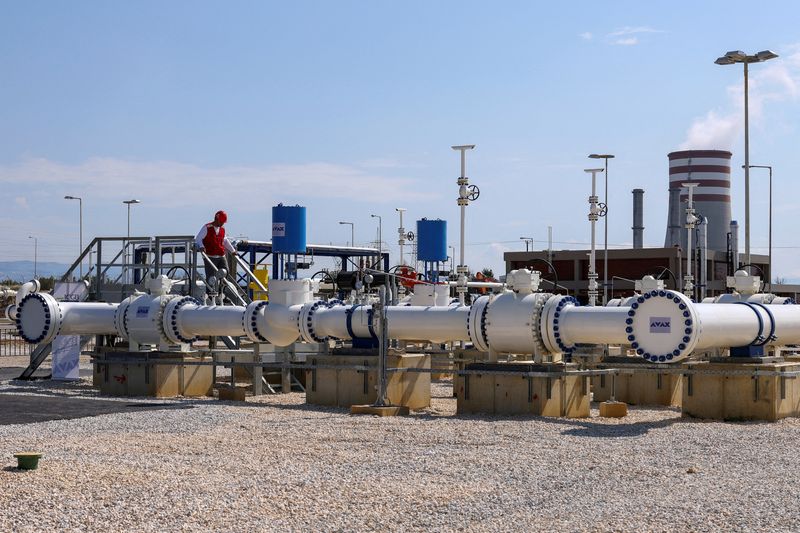By Susanna Twidale, Marwa Rashad and Nina Chestney
LONDON (Reuters) - The European Union will have plenty of gas in stock next winter and the remaining buyers of Russian pipeline gas in central Europe are working on alternative imports in case transit via Ukraine stops from January, analysts and companies said.
European gas prices have fallen to levels seen prior to Russia's February 2022 invasion of Ukraine this year, touching a three-year low in February, as mild weather and high renewable power output curbed gas demand and reduced the amount of gas that has needed to be taken from storage.
However, a deal signed in 2019 between Ukraine’s Naftogaz and Russia’s Gazprom (MCX:GAZP) allowing Russian gas to flow via Ukraine is set to expire at the end of the year, raising fresh concern about potential disruptions to European gas supply.
Ukraine said earlier this month it does not plan to extend the deal although it's unclear whether it would allow a loophole whereby European companies could book the transit capacity themselves avoiding a direct deal between Russia and Ukraine.
With just a few days left of Europe’s winter gas season, which ends on March 31, Europe’s gas stores are 59% full, a record high for the time of year, Gas Infrastructure Europe data shows.
“Europe is on course for another record high in start-of-summer inventories and it looks like the continent will again be on course to fill its storage sites (for next winter) early,” said James Waddell, head of European gas and global LNG at consultancy Energy Aspects.
As part of EU mandates set following Russia's invasion of Ukraine, Europe’s gas storage sites must be 90% full by Nov. 1.
Gas held in storage typically accounts for around a quarter of Europe's winter gas use, where it is a major heating fuel, and high stock levels should leave Europe well placed to meet supply next winter and avoid dramatic price shocks.
The most vulnerable countries in the EU are Austria and Slovakia as they still import a big chunk of their gas from Russia via Ukraine but even they say they are working on new sources of supply to limit the impact if supply is cut.
Gazprom has typically shipped around 40 million cubic metres (mcm) of gas a day via Ukraine transit routes in 2024, which if sustained would equate to an annualised rate of 14 billion cubic metres, or roughly 3.5% of total EU demand.
Around half of this gas goes to Austria via pipelines through Ukraine and then Slovakia. Austria’s energy major OMV said it has prepared for scenarios in which Russian gas supplies are interrupted.
A company spokesperson told Reuters via email it has contracted long-term liquefied natural gas (LNG) regasification capacity at the Gate terminal in Rotterdam. The Netherlands last year signed a five-year deal with Norway’s Equinor and has access to Europe’s spot markets.
Slovakia's SPP which also receives Russian gas via Ukraine said it continuously assesses gas market developments and the available options.
"The likely further loss of Russian gas will cause Europe to source gas from other places, where LNG will be the most important source," said Sindre Knutsson, senior vice president, gas and LNG Markets, Rystad Energy.
U.S. SUPPLY
Europe's supply will be bolstered by cargos of LNG from the United States which met almost 14% of EU gas demand last year, European Commission data showed, up from less than 4% just two years earlier.
A huge gap between U.S. and European gas prices, means Europe will remain an attractive destination for U.S. gas.
"At the moment, U.S. LNG is setting the price in Europe,” said Edoardo Campanella, an energy economist at UniCredit.
Europe's benchmark TTF front-month gas price is currently around four times higher than the equivalent contract in the U.S.
Europe is also still receiving significant cargos of Russian LNG, which currently make up around 13-15% of Europe's total gas imports.
The war in Ukraine and sanctions on other products have led to questions about whether Russian LNG imports to Europe should be blocked, but without unanimity among member states on the issue Russian cargos are expected to continue to arrive next winter.
"Currently high gas inventories in Europe and gradually increasing U.S. LNG exports cannot provide open-ended protection from the supply risks that an EU ban on Russian LNG would create," said Jake Horslen, senior LNG analyst at Energy Aspects.
EU countries have so far avoided applying sanctions to imports of Russian gas or LNG, on which countries including Austria and Hungary are still heavily dependent.
Six analyst forecasts collated by Reuters estimated the benchmark Dutch TTF gas contract would be in a range of 29-37.5 euros per megawatt hour for the next winter period over Q4 2024 and Q1 2025, roughly equivalent to $9.25-$12 per million British thermal units (mmBtu) in U.S. and Asian gas pricing.

This compares with current prices of around 27.45 euros/MWh ($8.71/mmBtu).
Energy Aspect's Waddell however said an end to the Ukraine flows could add around 10 euros/MWh to gas prices this winter.